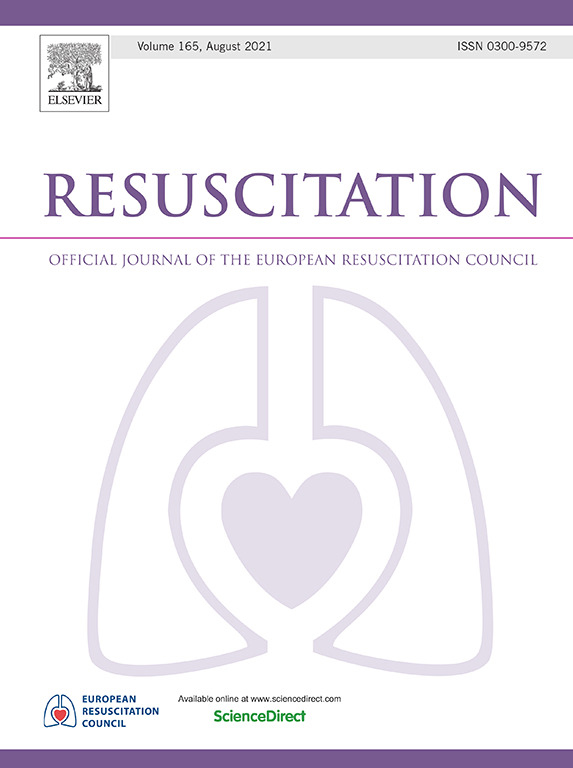Impact of dispatcher-assisted cardiopulmonary resuscitation policy on outcomes following out-of-hospital cardiac arrest: an interrupted time series analysis
IF 4.6
1区 医学
Q1 CRITICAL CARE MEDICINE
引用次数: 0
Abstract
Background
Despite the increasing adoption of dispatcher-assisted Cardiopulmonary Resuscitation (DA-CPR), evidence on its efficacy remains relatively scarce in developing countries. This interrupted time-series study assessed the impact of the DA-CPR policy on Out-of-hospital cardiac arrest (OHCA) outcomes in Shanghai, with the aim of informing evidence-based improvements in emergency care systems.
Methods
This study analyzed OHCA data reported by the Shanghai Medical Emergency Center from January 2019 to July 2024. Joinpoint regression analysis was used to identify and adjust for the impact of COVID-19 on OHCA outcomes. A modified autoregressive integrated moving average (ARIMA) model was used to quantify changes in outcomes before and after the implementation of the DA-CPR policy. Counterfactual analysis simulated OHCA outcomes trajectories without the policy, providing visual demonstration of the policy’s effects.
Results
Among 75,628 OHCA cases (median age 85), annual OHCA incidence ranged from 144 to 287 per 100,000 population, with age-standardized rates of 60 to 105. The average bystander CPR rate was 4.643% (age-standardized: 10.554%), the average ROSC rate was 2.914% (age-standardized: 4.799%), and the 30-day survival rate was 0.376% (age-standardized: 1.379%). Time-series analysis showed a significant post-policy level increase of 3.553 percentage point in bystander CPR (95% CI 1.227–5.879, P < 0.05), 2.215 percentage point in ROSC (95% CI 1.052–3.380, P < 0.001) and 0.461 percentage point in 30-day survival (95% CI 0.025–0.898, P < 0.05).
Conclusions
DA-CPR implementation substantially improved OHCA outcomes in Shanghai, supporting its adoption in developing countries to optimize emergency care outcomes.
调度员辅助心肺复苏政策对院外心脏骤停后预后的影响:中断时间序列分析。
背景:尽管越来越多地采用调度员辅助心肺复苏(DA-CPR),但关于其疗效的证据在发展中国家仍然相对缺乏。这项中断时间序列研究评估了DA-CPR政策对上海院外心脏骤停(OHCA)结果的影响,旨在为急诊护理系统的循证改进提供信息。方法:本研究分析2019年1月至2024年7月上海市医疗急救中心报告的OHCA数据。采用联点回归分析确定并调整COVID-19对OHCA结果的影响。使用改进的自回归综合移动平均(ARIMA)模型来量化实施DA-CPR政策前后结果的变化。反事实分析模拟了没有政策的OHCA结果轨迹,提供了政策效果的可视化演示。结果:在75,628例OHCA病例(中位年龄85岁)中,OHCA年发病率为每10万人144 - 287例,年龄标准化率为60 - 105例。平均旁观者CPR率为4.643%(年龄标准化:10.554%),平均ROSC率为2.914%(年龄标准化:4.799%),30天生存率为0.376%(年龄标准化:1.379%)。时间序列分析显示,政策出台后旁观者CPR的水平显著提高了3.553个百分点(95% CI 1.227-5.879)。结论:DA-CPR的实施显著改善了上海的OHCA结果,支持发展中国家采用它来优化急诊护理结果。
本文章由计算机程序翻译,如有差异,请以英文原文为准。
求助全文
约1分钟内获得全文
求助全文
来源期刊

Resuscitation
医学-急救医学
CiteScore
12.00
自引率
18.50%
发文量
556
审稿时长
21 days
期刊介绍:
Resuscitation is a monthly international and interdisciplinary medical journal. The papers published deal with the aetiology, pathophysiology and prevention of cardiac arrest, resuscitation training, clinical resuscitation, and experimental resuscitation research, although papers relating to animal studies will be published only if they are of exceptional interest and related directly to clinical cardiopulmonary resuscitation. Papers relating to trauma are published occasionally but the majority of these concern traumatic cardiac arrest.
 求助内容:
求助内容: 应助结果提醒方式:
应助结果提醒方式:


